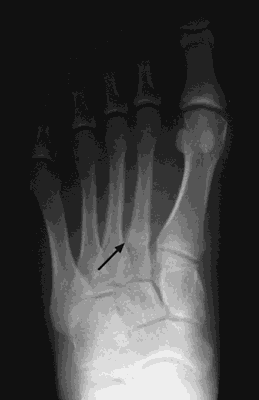callus
[kal´us]1. localized hyperplasia of the horny layer of the epidermis due to pressure or friction.
2. an unorganized network of woven bone formed about the ends of a broken bone; it is absorbed as repair is completed (provisional callus), and ultimately replaced by true bone (definitive callus).

A fracture with callus formation (arrow) is demonstrated corresponding to the base of the second metatarsal. From Thrall and Ziessman, 2001.
Miller-Keane Encyclopedia and Dictionary of Medicine, Nursing, and Allied Health, Seventh Edition. © 2003 by Saunders, an imprint of Elsevier, Inc. All rights reserved.
cal·lus
(kal'ŭs), Avoid substituting the adjective callous for this noun. Avoid substituting the nonword calloused for the past participle callused.1. Synonym(s): callosity
2. A composite mass of tissue that forms at a fracture site to establish continuity between the bone ends; it is composed initially of uncallused fibrous tissue and cartilage, and ultimately of bone. Synonym(s): fracture callus
[L. hard skin]
Farlex Partner Medical Dictionary © Farlex 2012
callus
(kăl′əs)n. pl. cal·luses
a. A localized thickening and enlargement of the horny layer of the skin. Also called callosity.
b. The hard bony tissue that develops around the ends of a fractured bone during healing.
intr.v. cal·lused, cal·lusing, cal·luses
To form or develop such hardened tissue. See Usage Note at callous.
The American Heritage® Medical Dictionary Copyright © 2007, 2004 by Houghton Mifflin Company. Published by Houghton Mifflin Company. All rights reserved.
callus
BotanyUndifferentiated plant tissue produced at wound edge, callus tissue can be grown in vitro and induced to differentiate by varying the ratio of the hormones auxin and cytokinin in the medium.
Dermatology
Callosity, tyloma—A focus of hyperkeratotic skin secondary to repeated friction or pressure.
Orthopaedics
A mass of indurated bony trabeculae and cartilage formed by osteoblasts early in healing fractures.
Podiatry
A focus of indurated hyperkeratotic skin with a smooth centre, which is usually avascular, caused by rubbing or pressure; typically seen on the plantar aspect beneath the metatarsal head, as well as on the heel and Achilles tendon.
Aetiology
Increased intermittent pressure on the skin; abnormal varus or valgus of foot leading to uneven weight distribution; local bone defect (plantar flexed ray, heel spur), long metatarsal, extrinsic pressure (improper footwear); surgical scars or lacerations.
Management
Trimming of the hyperkeratosis to the central core, soaking (e.g., epsom salts), and shaved regularly; to redistribute weight-bearing, a full-sole orthotic, footwear change and a metatarsal pad or hammer-toe crest pad if needed.
Prevention
Properly fitted shoes.
Segen's Medical Dictionary. © 2012 Farlex, Inc. All rights reserved.
callus
Callosity, tyloma Dermatology Localized hyperkeratosis of skin 2º to repeated friction or pressure Orthopedics A mass of indurated bony trabeculae and cartilage formed by osteoblasts early in healing fracturesMcGraw-Hill Concise Dictionary of Modern Medicine. © 2002 by The McGraw-Hill Companies, Inc.
cal·lus
(kal'ŭs)1. Synonym(s): callosity.
2. A composite mass of tissue that forms at a fracture site to establish continuity between the bone ends; it is composed initially of uncallused fibrous tissue and cartilage, and ultimately of bone.
Medical Dictionary for the Health Professions and Nursing © Farlex 2012
callus
1. A collection of partly calcified tissue, formed in the blood clot around the site of a healing fracture. Callus is readily visible on X-ray and indicates that healing is under way.
2. A skin thickening (see CALLOSITY).
Collins Dictionary of Medicine © Robert M. Youngson 2004, 2005
callus
a mass of immature plant cells which can differentiate into mature tissues, depending upon the relative concentrations of plant growth hormones present. Callus can develop from EXPLANTS in laboratory tissue culture experiments but also occurs naturally at the end of cut or wounded surfaces of shoots and roots.Collins Dictionary of Biology, 3rd ed. © W. G. Hale, V. A. Saunders, J. P. Margham 2005
Callus
Thickened skin due to chronic rubbing or irritation.
Mentioned in: Lichen Simplex Chronicus
Gale Encyclopedia of Medicine. Copyright 2008 The Gale Group, Inc. All rights reserved.
cal·lus
(kal'ŭs)1. Synonym(s): callosity.
2. A composite mass of tissue that forms at a fracture site to establish continuity between the bone ends.
Medical Dictionary for the Dental Professions © Farlex 2012